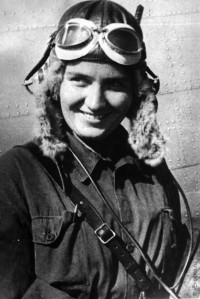The Night Witches were the world’s first all-female flight unit, a Soviet regiment who became feared amongst Nazi pilots during the Second World War.

The story of The Night Witches begins with record-breaking Russian aviatrix Marina Raskova. Marina was a shero in her own right; she had become the first female navigator in the Soviet Air Force in 1933, had gone on to break several distance records and was one of the first women (along with fellow pilots Polina Osipenko and Valentina Grizodubova) to receive the Hero of the Soviet Union award. All this had earned Marina a certain level of fame and notoriety in Soviet Russia.
When the Second World War began many Russian female pilots tried to volunteer their services to the Soviet Air Force – normally however, these attempts were blocked. Some women were so eager to help that they had actually stolen a plane and had away with it! Marina could see the great potential that her and her fellow female pilots held, so she used her fame and influence to convince Joseph Stalin that an all-female regiment was a cracking idea – and that an official unit would prevent any more hi-jinx plane-thieving!
In fact, not one, but three units were formed in the Soviet Air Force which were made entirely of women: The 586th Fighter Aviation Regiment, The 125th Guards Bomber Aviation Regiment (which Marina commanded herself) and the 588th Night Bomber Regiment – which became better known as the Night Witches!
While the other two units eventually included men as well, the 588th (later renamed The 46th Taman Guards Night Bomber Aviation Regiment) remained all-female for the duration of the war. Even the engineers who worked on the planes were all women!
The 588th Night Bomber Regiment was led by Major Yevdokia Bershanskaya, another experienced pilot. Unfortunately the women were given some of the oldest, slowest planes the air force had – a small wood and canvas affair called a Polikarpov Po-2, originally designed in 1928 and nomally only used for training. Despite this the women made the most of what they had and learnt to put these small, light aircraft to the best use.
The planes would seat two pilots, but little else. Only 6 bombs could be carried at at time (and zero parachutes), so the pairs of women would have to complete mulitiple missions within one night! With nothing to protect them from the elements many complained of frostbite when returning from their night-time flights.
Not only this, but the planes were incredibly light – one story recalled how during a fierce snow storm women of the unit had to go and lay themselves along the wings of their small planes in the freezing weather to stop them from blowing away!
But what earned these women their infamous nickname was the particular bombing technique they developed. When on a mission the women would reach their target, fly in as low as possible and then cut their engines – gliding in silently to drop their bombs. The only noise that could be heard once the engines were silences was the ‘swish, swishhhh’ of the planes cutting through the air. The Nazi’s claimed that this noise brought to mind the sound of a witch flying on her broom, and so they coined the nickname, ‘Nachthexen’ – or Night Witches.
The size of the aircraft and the women’s ability to fly them so near to the ground meant that they were often undetected by radar. In addition the women would always fly in groups of three planes; while two of the planes distracted the Nazi searchlights, the third would fly in unseen to reach her target. So accurate were the women in hitting their targets that they became renouned amongst the Nazi pilots who were promised an Iron Cross (a medal) if they were able to shoot one down. Some of the Nazi’s believed (or spread rumours) that the women were being given special pills which gave them super night vision. As Night Witch, Nadezhda Popova said, “This was nonsense, of course. What we did have were clever, educated, very talented girls.”
By the end of the war it’s estimated that each woman in the Night Witches had flown over 800 missions! At it’s largest point the unit had approximately 80 women; sadly during their service 30 of these brave pilots died. 23 were awarded the Hero of the Soviet Union after the war had ended.
Find out more…
Here are some of the names of the individual sheroes who made up The Night Witches:
- Yevdokia Bershanskaya
- Yevgeniya Zhigulenko
- Tat’yana Makarova
- Nina Ul’yanenko
- Vera Bjelik
- Rufina Gasheva
- Polina Gelman
- Natalya Meklin
- Nadezhda Popova
- Yevgeniya Rudneva
- Irina Sebrova
- Hiuaz Dospanova
- Kaleriya Ryl’skaya
From Broomsticks to Biplanes is an interactive online exhibit all about The Night Witches, where you can find out much more detail about the women.
Watch this beautiful animation about pilot, Nadezhda Popova:


Reblogged this on Lenora's Culture Center and Foray into History.
Thank you for bringing out the story of the “Night Witches.” I only wish more people knew about their courage and bravery.
What a great name for a blog…Sheheroes.
I have finally started to blog again hope that you will stop by.
http://www.vintageaviation.wordpress.com